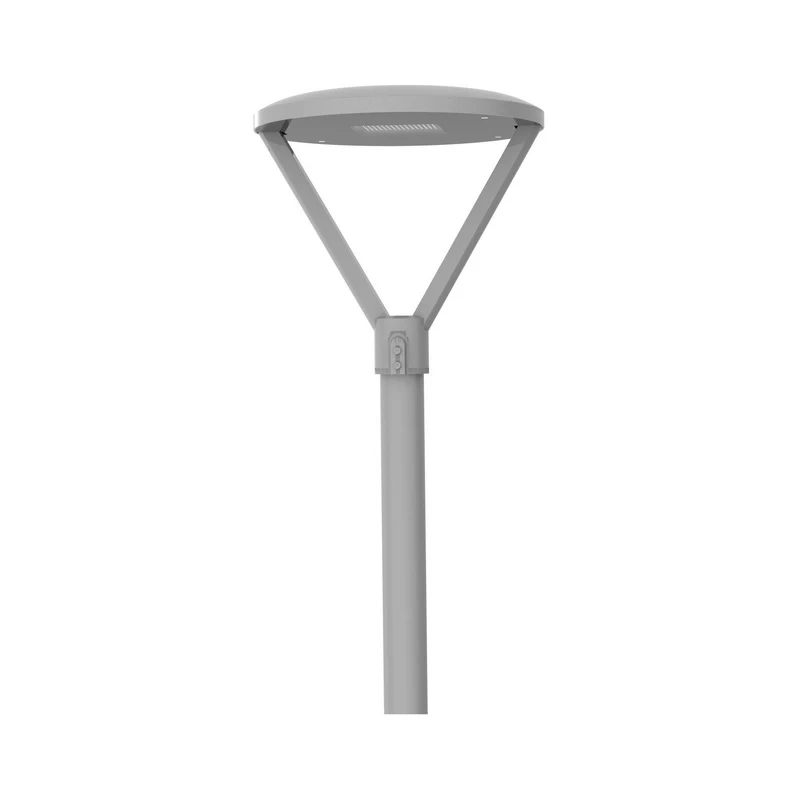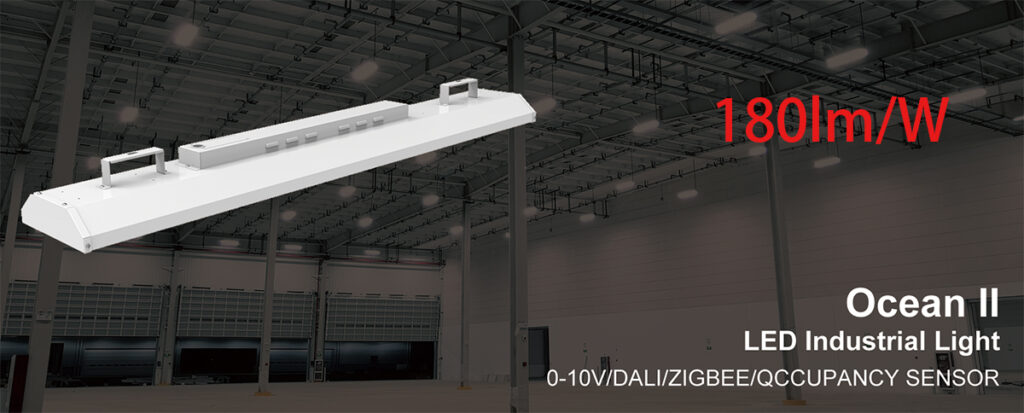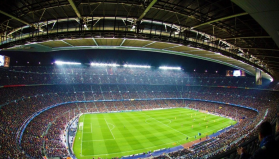目次
トグルはじめに
ワット、ルーメン、カンデラ、ルクスは、現代の照明ソリューション、特にLED技術の台頭を考慮する際に不可欠な3つの用語です。光のさまざまな側面を表現するために使用されるさまざまな用語や指標のために、照明を理解することは複雑な努力になる可能性があります。この記事では、これらの用語の定義を掘り下げ、その意味、相互の関連性、用語間の変換方法について説明します。

照明器具のワットとは?
ワットは、光源が消費する電力量を示す。ワット数が高いほど、消費電力も高くなる。
歴史的に、特に白熱電球では、ワット数が高いほど明るいとされてきた。しかし、LEDの進歩により、ワット数が明るさを直接示すことはなくなった。例えば、10ワットのLED電球は、60ワットの白熱電球と同じ光量を出すことができる。
- 1時間あたりの電力消費量(kWh)=電力(W)×0.001
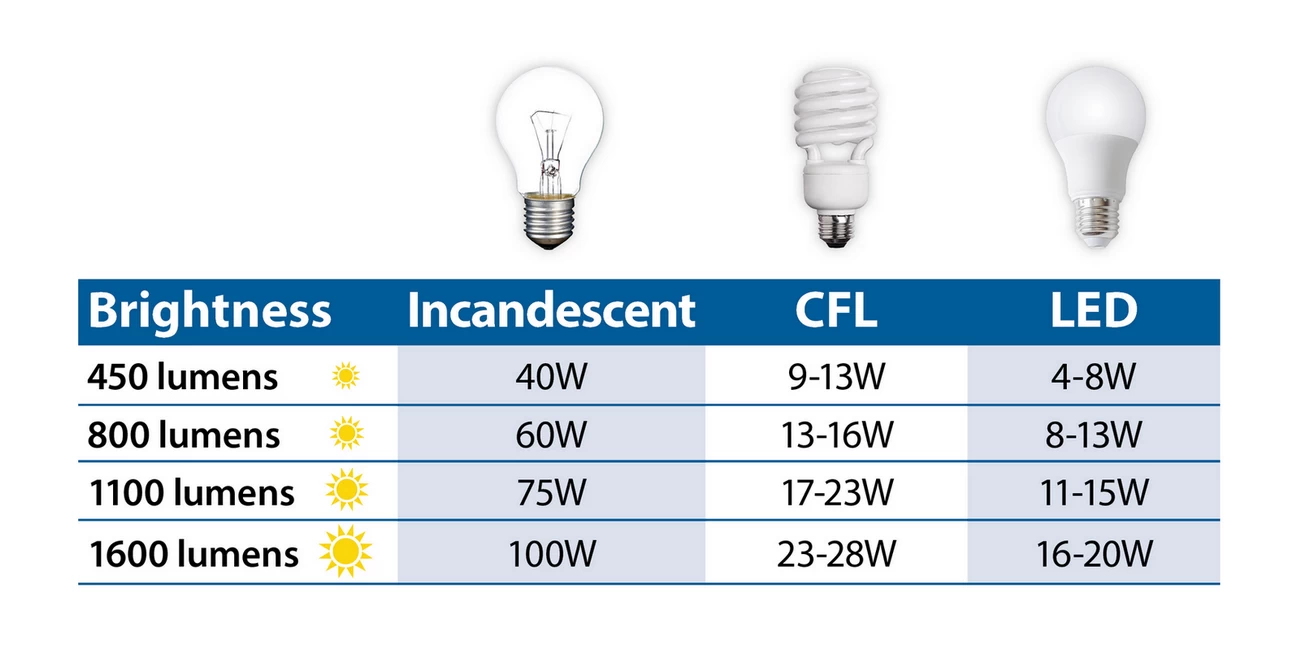
内腔の定義
ルーメン(略称lm)は光束の単位。ルーメンは、光源が放出する可視光の総量を測定する。ルーメンの数値が高いほど、より多くの可視光を放出し、明るく見える。ルーメンとワットは、発光効率(lm/W)に基づいて相互に変換されることが多い。
- ルーメンは、方向に関係なく、ランプが放出する光の総量を示す。
ラックスの定義
ルクスとは照度のことで、特定の面積にどれだけの光が届くかを表す。1ルクスは1平方メートルあたり1ルーメンに相当する。ルーメンが光源の発する光の量を示すのに対し、ルクスはその光が実際にどれだけの面積に届き、照らすかを示す。
ルクスが高ければ高いほど、照射面が明るくなる。同じパワーとルーメンのライトの場合、設置高さが高いほど表面照度(ルクス)は低くなります。
- ガレージの照明:100ルクスあれば十分で、これは1平方メートルあたり100ルーメンの明るさを意味する。
- 工場や倉庫:500ルクスが必要で、これは1平方メートルあたり500 lmの光量を意味する。
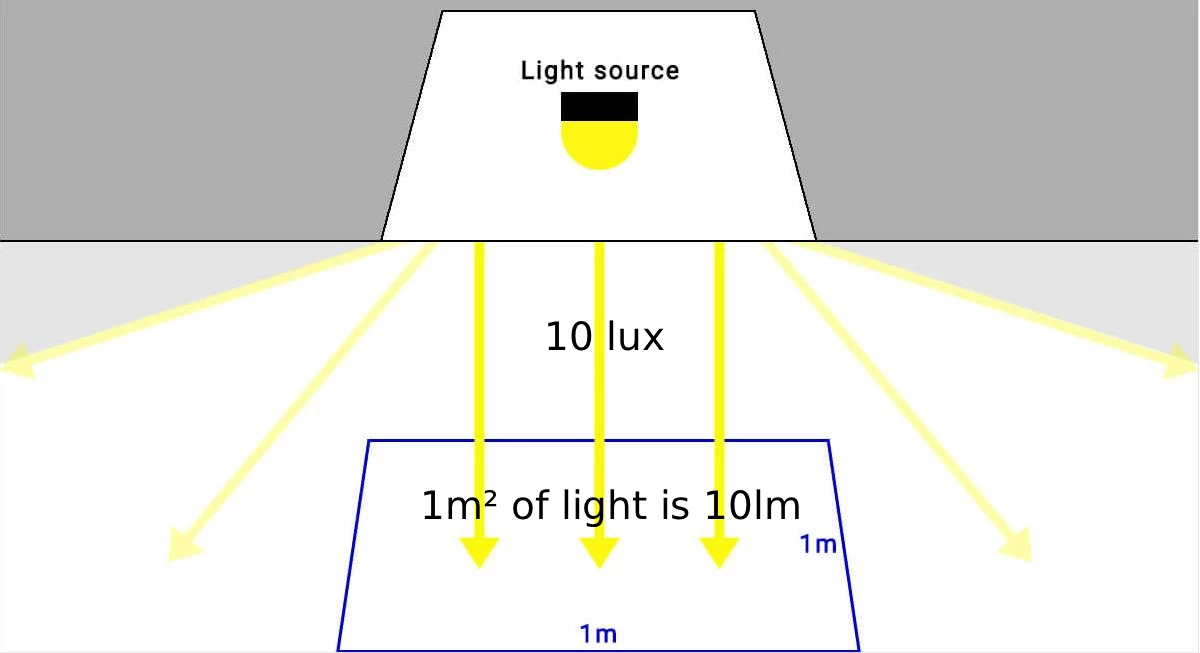
カンデラ 意味
カンデラ(記号cd)は光強度の単位で、光源が特定の方向に放出する光の量を表すのに使われる。光が一方向に集中するほどカンデラ値は大きくなり、光が分散するほどカンデラ値は小さくなる。
例えば、光が真正面から当たっている場合、光は真正面に最も集中するのでカンデラが最も高くなり、真横方向はカンデラが低くなる。
- 懐中電灯:前方の方が光量が強く、遠くまで照らせる。
- デスクランプ:光は分散し、全方向に低カンデラ。
カンデラとルーメンの比較
カンデラ(cd)とルーメン(lm)は、どちらも光学における物理の基本単位であるが、その中核となる定義は全く異なる。
- ルーメンは、光源が全方向に放出する可視光の総量を表す。
- カンデラは、特定の方向における光源の光度を表す。
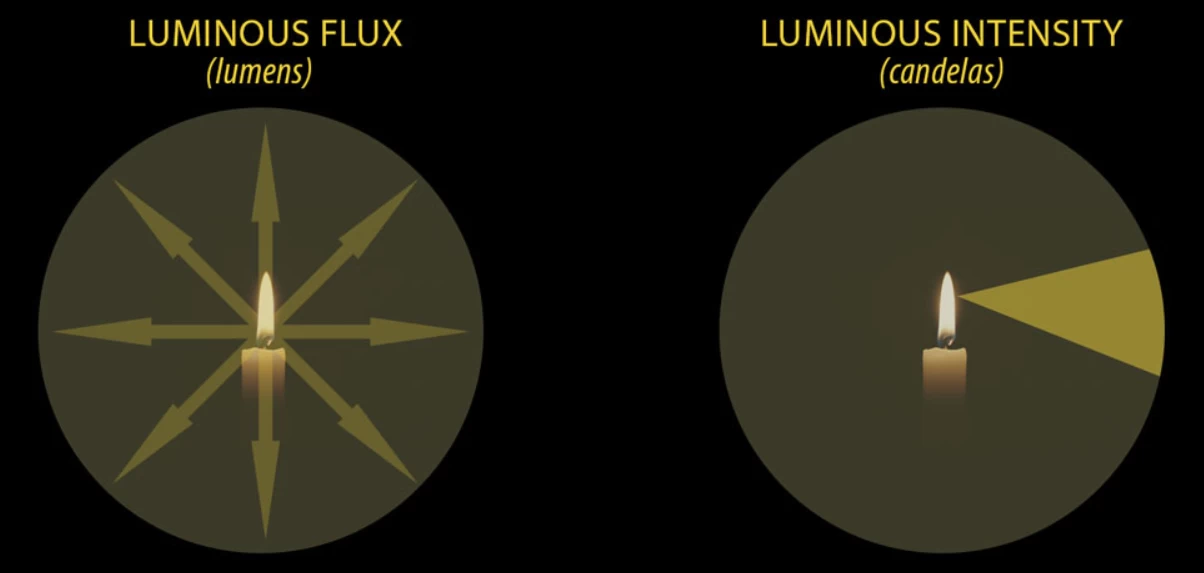
| 光源タイプ | カンデラ (CD) 意味 | ルーメン(lm)の意味 |
|---|---|---|
| レーザーポインター | キー(光が非常に集中し、cd値が非常に高い) | セカンダリー(総光量は非常に小さいかもしれない) |
| 車のヘッドライト | 重要(ビーム距離と中心部の明るさを決める) | 重要(全光束は照明範囲に影響する) |
| 屋内用電球 | あまり使われない | コア(部屋全体の明るさを決める) |
注:カンデラからルーメンへの変換はできません。光源のビーム角(立体角)を知る必要があります。例えば
- ビーム幅が狭い(10°)100cd光源は、総ルーメンが少なくなる。
- 広角(120°)の100cd光源は、より多くの総ルーメンを生み出す。
ルーメンをワットに変換
ワットからルーメンへの変換は、光の発光効率(lm/W)によって大きく異なります。光源の種類(白熱灯、ハロゲン、蛍光灯、LED)や、同じ光源でもブランドやモデルによって発光効率は異なります。
つまり、ルーメンとワットを変換するには、光の発光効率(lm/W)を知るだけでよい。
- ルーメン・ワット計算機:ワット=ルーメン÷発光効率(lm/W)
- ワット→ルーメン計算機:ルーメン=ワット×発光効率(lm/W)
ルーメン-ワット換算表 例:発光効率は100lm/W
| ルーメン (lm) | ルーメン/ワット | ワット (W) |
|---|---|---|
| 800lm | ルーメン(lm) ÷ 100 lm/W | 8W |
| 1000lm | 10W | |
| 1500lm | 15W | |
| 5000lm | 50W | |
| 10000lm | 100W |
この換算表は一例です。お使いのライトの実際の光効率に基づいて計算してください。
ルクスをルーメンに変換
ルーメンは可視光の総発光量を示し、ルクスは1平方メートルの表面で何ルーメンの光を受けるかを示す。
したがって、ルクスをルーメンに変換する際には、照射面の面積を知る必要がある!ルクスは面積に関する密度の単位であり、面積を考慮せずにルーメンに変換することはできない。
ルクスをルーメンに変換したり、ルーメンをルクス電卓に変換します:
- ルーメン(lm) = ルクス(lx) × 面積(㎡)
- ルクス(lx) = ルーメン(lm) ÷ 面積(㎡)
ルクスからルーメンへの変換ステップ:
- ルクスメーターを使って、照らされた面(テーブルの上、床)の照度(lx)を測定する。例えば、500ルクス。
- 長さと幅を測り、面積を計算する:面積=長さ(m)×幅(m)例えば、2 ㎡。
- ルーメンの計算:1000(lm)=500(lux)×2(㎡)。
| ターゲット | エリア | コンバート | 説明 |
|---|---|---|---|
| デスク表面の照度は500ルクスに達する | 0.72 ㎡ | 500ルクス×0.72 ㎡ = 360 lm | 光束≥360 lmの照明が必要。 |
| 部屋の照明が十分明るいか 照明器具 1000lm | 12 ㎡ | 1000 lm ÷ 12 ㎡ ≒ 83 lx | 部屋の推奨照度より低い 追加の光源が必要である! |
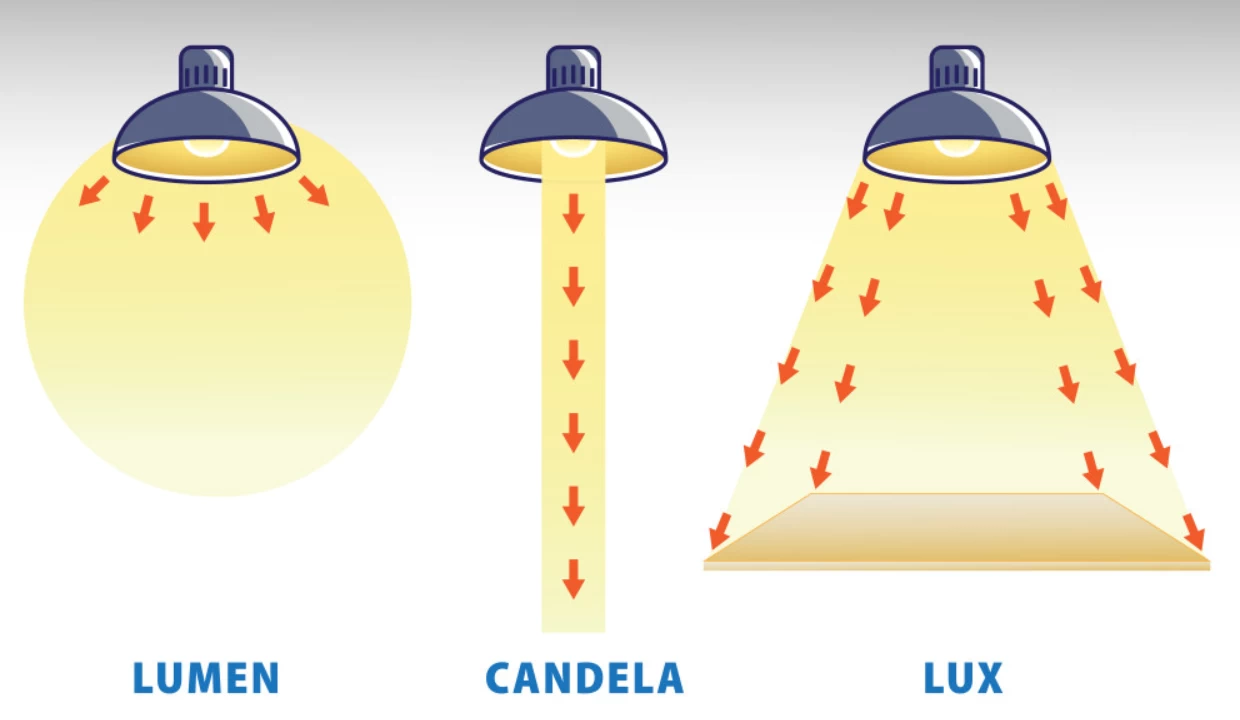
ルーメン vs カンデラ vs ルクス
| コンセプト | 定義 | 単位 | 主な特徴 | 例 |
|---|---|---|---|---|
| 光束 | 光源から放射される光の総量 | ルーメン (lm) | 方向性に関係なく「総額」を重視 | すべての光を放つ電球 |
| 光度 | 特定方向の光の強さ | カンデラ (CD) | 光の集中度「指向性」を重視 | 懐中電灯ビーム |
| 照度 | 表面の照度 | ルクス(lx) | 照らされた物体」、単位面積当たりの光を重視 | 机上の明るさ |
要約する
結論として、ルクス、ルーメン、ワット、その他の照明用語の関係を理解することは、産業用・商業用照明ソリューションの意思決定を行う上で非常に重要です。異なる場所や照明ニーズに直面した場合、これらのユニットは照明の種類や設置方法が異なります。
人々はこうも尋ねる
100ワットの電球は何ルーメンですか?
ワットとルーメンの間に決まった変換関係はなく、発光効率(lm/W)を決定しなければならない。
- 100W白熱灯(12-16 lm/W):1200-1600 lm
- 100W CFL (50-60 lm/W):5000-6000 lm
- 100W LED (80-100 lm/W):8000-10000 lm
ワット数が大きいほどルーメン値も大きくなるのか?
厳密に言えば、ワット数が高ければルーメンが高いとは限りません。この2つの関係は、光源の発光効率(lm/W)によって決まります。
- 異なるランプタイプ:
100W 白熱灯 → 1500 lm; 20W LED → 1800 lm - 同じランプタイプ:
100W LED (80 lm/W) → 8000 lm; 80W LED (130 lm/W) → 10400 lm
ルーメン値が大きければ大きいほど、ルクスも大きくなるのか?
必ずしもそうとは限りません。光源から放射されるルーメンが増えても、配光面積が増えれば、ルクス値は変わらないか、あるいは下がることさえある。
例えば、同じライトでもビーム角や取り付け高さが異なれば、照射範囲に影響が出る。
カンデラの値を決める要素はどれか?
カンデラ(cd)の値は通常、光束と照射角度によって決まります。ルーメンが大きいほど、また照射角が小さいほど、カンデラは大きくなります。
最大ルクスの方がいいのか?
もちろんそんなことはない。シーンによって推奨されるルクスの範囲があります。高すぎても低すぎても照明体験に影響する。
高すぎると、まぶしさ、眩しさ、疲労を引き起こし、安全上のリスクをもたらすことさえある。手術室や工場であれば、ルクスを高くすることで効率と安全性を確保できる。




